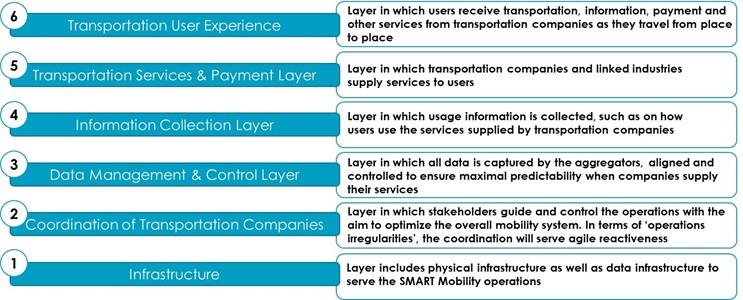Let’s crack SMART Mobility now!
The increased maturity and convergence within the mobility landscape together with the lessons learned from the COVID-19 era brings the opportunity to step away from the SMART Logistics Concepts and make SMART Logistics in Cities real. With the slow resumption of transport and mobility post COVID-19, cities have every interest now to properly organize and manage mobility streams. We at Avertim believe that cities should be in the lead to outline the objectives, bring together all the stakeholders, share best practices of industries such as aviation, and define the scope of the SMART Logistics is the short-term.

Let’s look at the bright side of life…
Looking at the other side of COVID-19; there has been a decline in traffic congestion issues for commuters and a drastic drop in CO2 emissions in cities as the car-centric world turned to remote working. Unfortunately, nothing seems to indicate that we will not switch back to the previous reality once the pandemic is over unless stakeholders involved decide to make a difference now! Whereas themes as SMART Cities on a conceptual basis has been amongst us for years, some of the components, like SMART Mobility, are now ready to be applied, tested and generate lessons learned from the ‘roll out’.
Context
The moment to put SMART Mobility in practice is now
The question is: Are the elements part of the SMART Mobility mature enough so that cities can apply them to their own benefits as well as their commuters?
Whereas one of the most ambitious new models is the so called “Mobility as a Service”, which is based on a sharing economy model, it is our opinion that for cities to become Mobility SMART, they will go through different phases. Any MaaS (Mobility as a Service) governance framework should contribute to a modal shift and guarantee the transport authority’s ability to organize mobility on its territory on equal and inclusive terms. Shared mobility solutions should not replace, but complement and feed mass transit services, which remain the backbone of urban mobility.
So, can the concept of SMART Mobility be implemented and tested right now? We think that the moment has arrived, especially given the gradual lift of the restrictions of the pandemic and the arrival of the summer season. It could be wiser to test this concept in touristic towns which are not the typical capitals and big cities, but rather those smaller ones, facing an influx of visitors and still having to deal with the COVID-19 measures (distance, density,…).
What is needed to assist these towns in smartly managing the mobility flows and serving the consumers with the right transport modes? 6 different layers need to be implemented (see overview).

In our opinion, layers 1 and 2 are the least developed. Infrastructure means on the one hand installing hubs for travelers to transfer transport modes, but also electric charging points, toll installations and bike and pedestrian paths. The element ‘coordination’ in the 2nd layer needs to be further stimulated. To proceed with this new way of mobility as a service, an alliance of the stakeholders needs to be established between the commuters, aggregators, and service providers around the life cycle of the new mobility system. In terms of controlling individual transport modes, capturing data and applying them on crowd and flow management progress have been made, yet the collaboration between the different companies involved must be invigorated. This is a question of building trust and understanding that all organizations involved serve the same goal after all.
Consequently, in the start-up phase of testing SMART Mobility it will be a hybrid model. Most importantly is that the foundations are there to pilot the system, make it work and collect means to improve the maturity of SMART Mobility along the way.
As indicated, launching this concept right now also means that some of the additional data, resulting from COVID-measures, needs to be considered in layer 3 and 4. For instance, during the first weeks of spring in Belgium, trains entering the coastal towns were overloaded and were not able to manage the flows even with the use of many cameras, guardians, and police. This scenario proves that, despite having proper means, most often corrective actions are taken reactively and do not serve the overall mobility efficiency. Not to mention user convenience. These cities should also assess which lessons can be drawn from the COVID-19 crisis, putting the emphasis on measures that improve the resilience of public transport systems and prepare them for future disruptive events. Such measures could include enhancing the flexibility of operations, new hygiene concepts, more automation, and different engagement with customers.
From a technological point of view, layers 5 and 6 are in development with apps and systems, yet currently not covering the full user/customer experience. To that extent building layers 5 and 6 is more an integration matter.
Next Steps
According to our opinion cities can also rely on best practices in industries such as the aviation sector to take a leap forward and use proven methodologies. Of course, it is not a question of copying these technologies, yet investing in the lessons learned and talking to the different stakeholders and companies involved. This will make the SMART Mobility tests practically more manageable and avoid unnecessary efforts. In the airport industry, the EU supported and subsidized SESAR Projects (Single European Sky), and since 2014 many airports have made progress in establishing the Stakeholder Control Centres (Airport Operations Centre) and the Airport Operations Plan (AOP). The purpose of the AOP is to use predictive data to improve processes and passenger experiences at the airport. Cities should be in the lead to bring the various stakeholders around the table, exchange best practices, formulate clear concrete short-term objectives and definea feasible pilot scope together with various parties.
Written by

- Bart S., Strategic Director, Avertim
